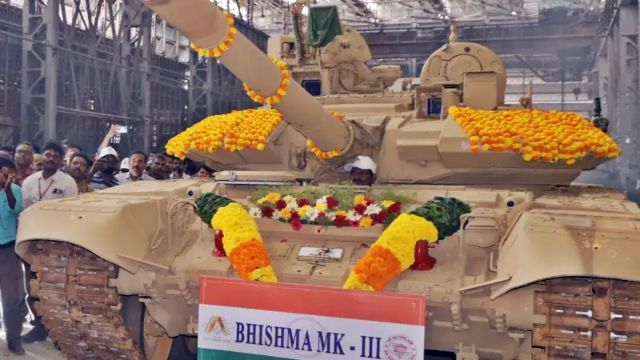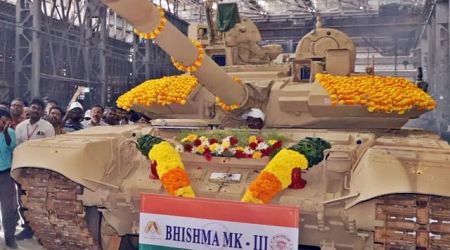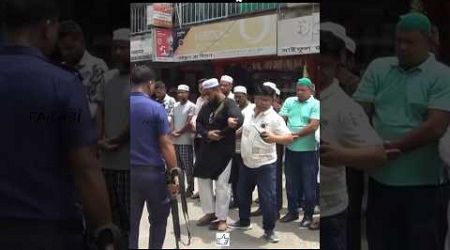The Cold War Stockpile
The War in Ukraine was largely unexpected from both allies of Ukraine as well as many Russian commanders themselves as little to no new weaponry was produced in large quantities prior to the beginning of the conflict. Leadership in Russia likely assu

Indian Produced T-90 Mk.III, a licensed and improved version of the Russian T-90 tank.
The War in Ukraine was largely unexpected from both allies of Ukraine as well as many Russian commanders themselves as little to no new weaponry was produced in large quantities prior to the beginning of the conflict. Leadership in Russia likely assumed that the assault on Kyiv would be swift and that trench style warfare would not take place in an era with rapid, modern tanks and armoured vehicles linked to GPS. The end result was trenches and drones and long range artillery with accuracy only dreamed of in the 1980s. While most of the Soviet stockpile was made to fight a Third World War in the late 70s and early 80s, it is now almost depleted in the mid-2020s.
Russia had large stockpiles of Soviet equipment in garages and sitting in fields all over Russia by the mid-2020s. Newer modern systems are often based on the late Cold War platforms with computer assisted communications and targeting equipment, designed to be an export product to nations who were looking for an economical, world class platform. When Russia lost many of these more advanced systems, they started taking equipment from their active reserves, then from working tanks from their stockpile, then upgrading the Soviet tanks to a modern standard, and now taking even 1960s era systems with an odd 115mm calibre to use as fire support for infantry. Russia has gone as far as purchasing weapons and ammunition from North Korea, much of it being of an older Soviet design and with additional problems due to quality controls. The race for modern tanks however may not be solved through these purchases, and both the Western allies and Russia may both have the option to purchase the last remaining large stockpiles of tanks for their forces in Ukraine.
Russia had a modernisation program based on the T14 Armata tank’s hull and chassis to re-equip their armed forces. The Armata platform would be utilized with new tanks and vehicles with the best technology and protection available in the post 2010s era. With the cost of the Armata being quite high however, and the requirements for the current war being one of needing more units as opposed to a few highly advanced units, it looks like the modernisation program will be focused on older models as opposed to a newly produced Armata based production. While the production for the T-80 series appears to no longer have the rationale past upgrades to make new tanks, the factory that produced the original T-72 has been working 24 hours shifts modernizing older tanks from storage to the T-72B3M standard and would likely focus on making the newer T-90M tanks if a new production run would take shape. Even with this large production push, Russia is still losing too many tanks, and both Russia and Ukraine will need to find a source of tanks that are significantly better than old T-62Ms and Leopard 1s.
The largest stockpiles of modern weapons that might be available for purchase lay in China and India. If China would decide to disengage from accelerating a conflict with Taiwan and continue as the world’s manufacturing hub, PLA land forces would be in excess of equipment and armour. China had to design the ZTQ15 light tank as it could operate effectively for use on the border with India, where many of their ZTZ99A and ZTZ96B tanks would struggle in a low oxygen/high terrain environment. After China’s 2008 Parade showing many new weapons systems to the public, many of these systems ended up being retired or put in rear units of the PLA after a few short years, despite being of a modern 2008 design. Tanks such as the ZTZ96B has similar characteristics to the newer T-72 versions and would suit both Russian and Ukrainian forces well in their conflict. Anti-aircraft systems like China’s PGZ-04A/PGZ95 is already largely being replaced by the PGZ09, and is like a modernised ZSU-23-4 Shilka, and would suit the anti-drone defence for Ukraine better than most of the early 80s Gepards currently being used. While it might be considered as a long shot to purchase armament from China for Ukraine, there have been many licensing agreements and commercial connections between Ukraine’s allies, particularly France and Germany, and it cannot be assumed that China would forgo a benefit to themselves for the sake of Russia in every instance. With China’s equipment being standard with many Soviet era artillery rounds, both Ukraine and Russia could integrate those systems with ease on the battlefield.
India’s currently has the license to produce the Russian designed T-90 tank and has production facilities making them in India for India’s armed forces. While it is unclear whether or not Russia has the ability to block exports of the Indian produced T-90 in their licensing agreement, India’s security situation requires an independent source for arms in the event its population is threatened. Due to India’s significance in its region and globally, they have been able to maintain relations with both sides of the conflict without enduring much pressure from either party. Besides equipment from France, India’s military has always sourced much of its equipment from non-NATO nations despite being the world’s largest democracy and having close ties to the West and its values. India has recently backed away from purchasing some modern Russian equipment after seeing the performance of the T-72/T-90 platform in Ukraine. India may be willing to sell part of its T-90 production if it can be compensated with other platforms as countries like Poland had chosen to do in displacing its T-72 based PT-91 Twardy tanks. While relational issues India might have with the West or Russia in selling T-90s to either side would be a topic of debate, any increased immediate threat to India, the region, or the larger world from India’s adversaries will push India to rapidly and unapologetically support its own best interests. India has already taken to supplying some weapons support to Armenia, even when Armenia has been abandoned by both traditional ally Russia, and the United States as the new player in the Caucasus region.
It may be the case that the usefulness of the traditional tank, with a large 125mm cannon and heavy ammunition, may not be the best system to use on the battlefield with so many threats from below the ground to nearly invisible drones above. Many weapons systems like the M2 Bradley use an autocannon to achieve its mission success and rely on speed, rapid fire and crew visibility in assaulting enemy positions and even challenging tanks themselves. The offensive use of Anti-Tank guided missiles can destroy most modern tanks and active and passive protection systems can be effective on systems using thinner armour. The Russian system called BMPT Terminator uses two BMP-2 style autocannons and four anti-tank missiles based on a T-72 hull designed as a response to tanks losses experienced in urban settings in Chechnya. This system uses modern vision and targeting equipment, and was initially one of the most feared systems to be encountered in Ukraine. These lighter systems may take over the role of the main battle tanks in future conflicts. The idea of having unmanned armoured vehicles may already be fielded in Ukraine. The Russian Uran-9 is essentially a drone armoured vehicle with an autocannon and anti-tank missiles akin to something you might see in an 1980s sci-fi movie, minus the growling and creepy voice. While many of these manned and unmanned tanks will be integrated with their own aerial drone support mechanisms, the war in Ukraine has established certain technologies over others, and will continue to do so as long as fighting continues in the region. We are at the cusp of the final stockpiles from the end of the Cold War, with no signs of less conflict in the world in 2024.
Related
Share this page

































